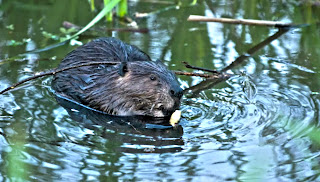Trinity River Beavers at Miller’s Ferry Crossing
 |
| Beaver at Trinity River Wetlands Miller’s Ferry near sunset |
Tucked away in a desolate remote and forgotten part of Dallas resides a family of beavers. That’s how most of my posts seem to start. Not so this time! Did not have to travel into one of the remote parts of the woods to find this. The beavers featured in photo above and youtube clip below actually live between I-45 and South Central Expressway in the heart of Dallas. Angry beavers. The kind that give you the stink eye and slap their tails. The video below has some tail slapping at the beginning, done to either scare me off or draw away my attention from wherever they live.
Video below of a beaver slapping it’s tail. When the camera pans out towards the end you will see the South Central Expressway Bridge in the background.
 |
| Beaver at Trinity River Wetlands September 2010 |
I’m not sure what makes even the most vulnerable animals in the Great Trinity Forest so aggressive. Maybe it’s the absence of human contact that generates a lack of fear. Animals like feral pigs and beavers that many consider to be nocturnal, can be seen during daylight hours here.
The beaver Castor canadensis is North America’s largest rodent, and the world’s second largest, after the capybara of South America. Beavers live in colonies of four to eight family members. Considered the best engineers among rodents, beavers construct dams with mud, brush, stones, poles, vegetation, and other materials to create safe lodging and a provide themselves with a good food supply.
 |
| Beaver Lodge in wetland cell north of Loop 12 Joppa Community |
The beaver whittlin’ on the stick above was a resident of the rather large beaver lodge in Wetland Cell G during the fall and winter of 2010-11. The beavers built their lodge right at the mouth of where Honey Spring enters the wetland cell.
Other than humans, beavers are probably the best animals at controlling their natural environment through construction. In the wetland cells they have it made since the water level is controlled via a series of flood gates and doors that provide a constant flow of water to the chain of wetlands.
The beavers are probably blamed for sabotaging the efforts of the Corps of Engineers to plant aquatic vegetation in the wetland cells. Below is an example of one type of cage designed to protect new plants from turtles and beavers. Some of the wire mesh enclosures are designed to catch turtles for replacement elsewhere. I think some of the Joppa residents figured this out and now enjoy turtle soup on a regular basis!
 |
| Ibis and juvenile egrets at Trinity River Wetlands |
Seeing the beavers from time to time, it seems that they eat mostly soft wood saplings from the treelines and not plants in the cages. What the beavers don’t eat, the Corps of Engineers tractors mow down on a semi-annual basis.
 |
| Beaver Lodge in Wetland Cells July 2011 |
By July of 2011 the beaver lodge constructed north of Loop 12 could not even be seen. Using mostly willow branches for construction many of the sticks took root and became small saplings themselves. This lodge might have been abandoned after Honey Springs went dry during the 2011 summer drought.
I have yet to see a nutria in this area. Maybe they are more nocturnal than the beaver. Last winter there were a group or maybe family of river otters in this same general area. I have not seen them in 2011.
More information on the Dallas Floodway Extension Project can be found on the official website here: Dallas Floodway Extension Project . The North Texas Municpial Water District operates a similar wetland on the East Fork of the Trinity River near Seagoville. Known as the John Bunker sands Wetlands. Their website can be found here: John Bunker Sands Wetlands. I imagine the Dallas Wetlands Project will one day be similar in scope to the North Texas Municipal Water District site. As it stands right now, the Dallas site lacks parking and the basic infrastructure needed to attract folks to visit.